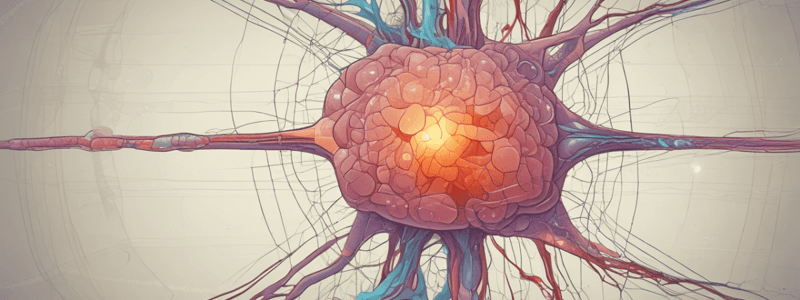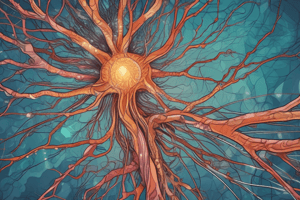Podcast
Questions and Answers
What is the typical resting membrane potential of a cell?
What is the typical resting membrane potential of a cell?
What determines the equilibrium potential of an ion?
What determines the equilibrium potential of an ion?
What is the primary function of the Na+/K+-ATPase pump?
What is the primary function of the Na+/K+-ATPase pump?
What type of recording is used to measure electrical potentials from inside a cell?
What type of recording is used to measure electrical potentials from inside a cell?
Signup and view all the answers
What is the primary component of the membrane that provides a hydrophobic barrier?
What is the primary component of the membrane that provides a hydrophobic barrier?
Signup and view all the answers
What is the result of the inside of the cell becoming very negative?
What is the result of the inside of the cell becoming very negative?
Signup and view all the answers
What is the purpose of the ion channels in the membrane?
What is the purpose of the ion channels in the membrane?
Signup and view all the answers
What is the result of depolarization of the cell membrane?
What is the result of depolarization of the cell membrane?
Signup and view all the answers
What is the primary function of the sodium pump in establishing the membrane potential?
What is the primary function of the sodium pump in establishing the membrane potential?
Signup and view all the answers
What is the term for the period of time during which an action potential cannot be generated?
What is the term for the period of time during which an action potential cannot be generated?
Signup and view all the answers
What is the purpose of patch clamping in measuring electrical potentials?
What is the purpose of patch clamping in measuring electrical potentials?
Signup and view all the answers
What is the property of the cell membrane that allows it to store charges?
What is the property of the cell membrane that allows it to store charges?
Signup and view all the answers
What is the term for the difference in electrical potential between the inside and outside of a cell?
What is the term for the difference in electrical potential between the inside and outside of a cell?
Signup and view all the answers
What is the role of voltage-dependent ion channels in generating the membrane potential?
What is the role of voltage-dependent ion channels in generating the membrane potential?
Signup and view all the answers
What is the term for the minimum amount of electrical potential required to generate an action potential?
What is the term for the minimum amount of electrical potential required to generate an action potential?
Signup and view all the answers
What is the purpose of extracellular recording in measuring electrical potentials?
What is the purpose of extracellular recording in measuring electrical potentials?
Signup and view all the answers
What is the primary function of sodium channels in a cell?
What is the primary function of sodium channels in a cell?
Signup and view all the answers
What is the result of the rapid influx of sodium into the cell through sodium channels?
What is the result of the rapid influx of sodium into the cell through sodium channels?
Signup and view all the answers
What is the primary function of potassium channels in a cell?
What is the primary function of potassium channels in a cell?
Signup and view all the answers
What is the result of the rapid efflux of potassium out of the cell through potassium channels?
What is the result of the rapid efflux of potassium out of the cell through potassium channels?
Signup and view all the answers
What determines the resting membrane potential?
What determines the resting membrane potential?
Signup and view all the answers
What are the two specific forces that ions are under?
What are the two specific forces that ions are under?
Signup and view all the answers
What is the equation used to calculate the resting membrane potential?
What is the equation used to calculate the resting membrane potential?
Signup and view all the answers
What is the value of the resting membrane potential under physiological conditions?
What is the value of the resting membrane potential under physiological conditions?
Signup and view all the answers
What is the primary cause of the depolarization of the neuron beyond the threshold?
What is the primary cause of the depolarization of the neuron beyond the threshold?
Signup and view all the answers
What is the effect of the inactivation of sodium channels?
What is the effect of the inactivation of sodium channels?
Signup and view all the answers
What is the purpose of the relative refractory period?
What is the purpose of the relative refractory period?
Signup and view all the answers
What is the typical resting membrane potential of a neuron?
What is the typical resting membrane potential of a neuron?
Signup and view all the answers
What happens to the potassium channels during the hyperpolarization phase?
What happens to the potassium channels during the hyperpolarization phase?
Signup and view all the answers
What is the primary function of the leak channels?
What is the primary function of the leak channels?
Signup and view all the answers
What is the result of the rapid entry of sodium ions into the neuron?
What is the result of the rapid entry of sodium ions into the neuron?
Signup and view all the answers
What is the purpose of the voltage-gated sodium channels?
What is the purpose of the voltage-gated sodium channels?
Signup and view all the answers
What is the typical voltage at which the voltage-dependent, transient Na+ channels open?
What is the typical voltage at which the voltage-dependent, transient Na+ channels open?
Signup and view all the answers
What is the primary function of the V-gated K channels?
What is the primary function of the V-gated K channels?
Signup and view all the answers
What is the term for the period of time during which the V-gated Na channels are inactivated?
What is the term for the period of time during which the V-gated Na channels are inactivated?
Signup and view all the answers
What is the primary difference between the conduction of action potentials in non-myelinated and myelinated axons?
What is the primary difference between the conduction of action potentials in non-myelinated and myelinated axons?
Signup and view all the answers
What is the term for the ability of an excitable cell to generate an action potential?
What is the term for the ability of an excitable cell to generate an action potential?
Signup and view all the answers
What is the typical concentration of Na+ ions inside a cell?
What is the typical concentration of Na+ ions inside a cell?
Signup and view all the answers
What is the term for the movement of ions across the cell membrane?
What is the term for the movement of ions across the cell membrane?
Signup and view all the answers
What is the term for the ability of a cell membrane to store electrical energy?
What is the term for the ability of a cell membrane to store electrical energy?
Signup and view all the answers
What is the term for the flow of electrical charge across the cell membrane?
What is the term for the flow of electrical charge across the cell membrane?
Signup and view all the answers
What is the term for the difference in electrical potential between the inside and outside of a cell?
What is the term for the difference in electrical potential between the inside and outside of a cell?
Signup and view all the answers
Study Notes
Establishing Electrochemical Potentials and Axon Potentials
- Electrochemical equilibria and membrane potential:
- The membrane separates and stores charges
- Na+ and K+ ion channels contribute to generating the membrane potential (MP)
- The differential permeability of the membrane to Na+ and K+ ions is significant
- Electrochemical gradients are established through the sodium pump, voltage-dependent ion channels, and membrane capacitance
- Action potential, propagation, and nerve conduction:
- Properties of the action potential (AP):
- Voltage and conductance changes during the AP
- Capacitance
- Threshold and refractory periods:
- What is meant by 'threshold' and 'refractory periods'
- Importance of myelin in nerve conduction
- Properties of the action potential (AP):
Measuring Electrical Potentials
- Methods of measuring electrical potentials:
- Extracellular recording (electrode outside the cell)
- Intracellular recording (electrode inside the cell)
- Patch clamping (electrode sealed to the cell surface)
- Measurement units:
- 100 mV (intracellular recording)
- 0.1 mV (extracellular recording)
Basic Principles
- At rest, the inside of the membrane is more negatively charged than the outside (hyperpolarized)
- When cells become activated, the inside of the membrane becomes more positively charged (depolarized)
The Resting Membrane Potential
- The resting membrane potential (Vm) is typically around -70 mV
- It is determined by Na+ and K+ ions (and Ca2+ ions)
- Equilibrium potential of an ion is the membrane voltage required to prevent movement of an ion down its concentration gradient
- If the inside of the cell is very negative, K+ will be prevented from leaving; if the inside of the cell is very positive, Na+ will be prevented from entering
The Membrane
- The membrane surrounds the entire neuron, providing a hydrophobic, relatively impermeable barrier
- Composed of lipids and proteins, with ion channels and pumps providing entry and exit routes for ions
- Na+/K+-ATPase pump:
- Uses energy (ATP) to actively pump three sodium (Na+) and two potassium (K+) ions out and into the cell, respectively
- Maintains a more depolarized internal environment
- Sodium channels:
- Permit the rapid influx of sodium into the cell upon opening, resulting in depolarization
- Potassium channels:
- Permit the rapid efflux of potassium out of the cell upon opening, resulting in hyperpolarization
The Action Potential
- The action potential is generated by the rapid influx of sodium ions and the rapid efflux of potassium ions
- The Nernst equation is used to calculate the equilibrium potential of an ion
- The action potential has five stages:
- Depolarization reaches threshold
- Voltage-gated sodium channels (NaV) open, and sodium ions (Na+) enter the neuron
- Rapid Na+ entry depolarizes the neuron further
- NaV channels inactivate, and slower (0.5 mS) potassium channels (Kv) open
- Potassium ions (K+) move out of the neuron, repolarizing it
Refractory Periods
- Absolute refractory period:
- Results from the inactivation of Na+ channels
- Lasts until the resting membrane potential is restored
- Relative refractory period:
- Results from the hyperpolarization phase
- During which a greater stimulus is needed to reach threshold
Functional States of Ion Channels
- Ion channels have three states:
- Closed (resting)
- Open (active)
- Inactive (refractory)
- V-gated Na channels have all three states, while V-gated K channels have no inactivation state
Action Potential Conduction
- Action potential conduction in non-myelinated axons:
- Involves the continuous generation of action potentials along the length of the axon
- Action potential conduction in myelinated axons:
- Involves the saltatory conduction of action potentials between nodes of Ranvier
- The myelin sheath insulates the axon, increasing the speed of transmission
Studying That Suits You
Use AI to generate personalized quizzes and flashcards to suit your learning preferences.
Related Documents
Description
This quiz covers the physiology of electrochemical potentials and axon potentials, including the concentrations of Na+ and K+ ions inside and outside of cells and how electrical events are measured.




